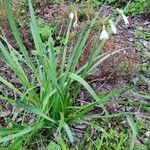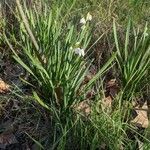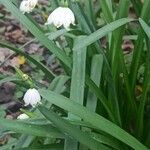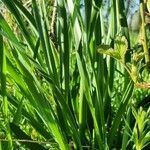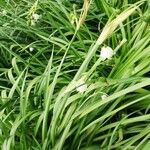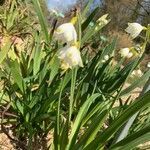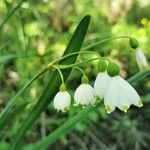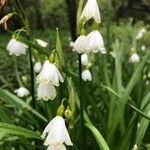A bulb plant. It grows 45-60 cm high and 10-15 cm wide. The leaves are strap shaped and 5-20 mm wide. They grow in clumps. The leaves are bright deep green. The flower stem is green. The flower stem is sturdy and leafless and carries several white bells. They have green markings just above the tips of the segments. These bell shaped nodding flowers are 18 mm wide.
Bulb 25-40 mm diam. Leaves flat, obtuse, to 50 cm long, 0.5-2 cm wide, dark green. Scape to 60 cm long, flattened, narrowly 2-winged. Pedicels 1.5-6 cm long; flowers scented. Sepals and petals obovate, obtuse, 10-16 mm long, white with green spot below apex. Stamens 7-8 mm long including anther 4 mm long. Style 8-9 mm long; ovary ellipsoidal, c. 6 mm long.
Bulb ovoid, c. 2.5 cm diam. Leaves 3-6, c. = scape, 8-15 mm wide, linear-lorate, bright green. Scape 30-60 cm high, hollow, ± compressed. Flowers (1-2)-3-7, 1.5-2 cm long, < 1.5 cm diam,. campanulate, white with green-tipped segments; spathe 3-5 cm long, green at apex. Capsule almost globose. Seeds black.
Scape 2–4 dm; lvs 3–4 dm, ca 1 cm wide, obtuse; bract foliaceous, 3–5 cm; fls 2–8, on long drooping peduncles; perianth campanulate, ca 2 cm, the tep white, edged with green; 2n=22, 24. Native of Europe, locally established in our range as an escape from cult.
Umbel 3-5(-7)-flowered; perigone-lobes 1-1.5 cm long.
